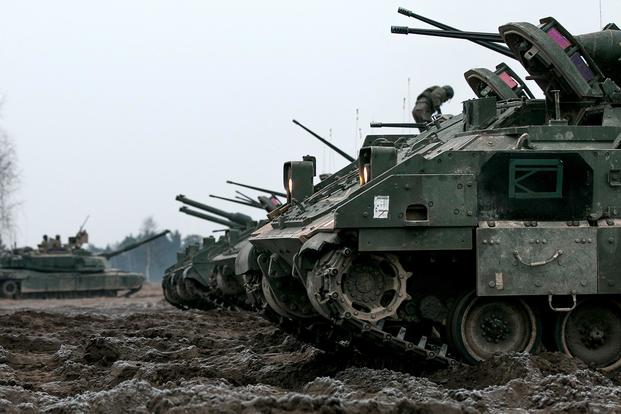Army maneuver officials on Monday said the service's Next Generation Combat Vehicle will allow it to team manned and unmanned vehicles and create an unbeatable overmatch against enemy armored forces.
Developing the NGCV to replace the fleet of Cold-War era M1 Abrams tanks and Bradley Fighting Vehicles is the Army's second modernization priority under a new strategy to reform acquisition and modernization.
The Army intends to stand up a new Futures Command this summer, which will oversee cross-functional teams that focus on each of the of the service's six modernization priorities: long-range precision fires; next-generation combat vehicle; future vertical lift; a mobile and expeditionary network; air and missile defense capabilities; and soldier lethality.
"The Next Generation Combat Vehicle needs to be revolutionary," Gen Robert Abrams, commander of Forces Command, told an audience at the Association of the United States Army's Global Force Symposium.
"It's got to be 10X better than our current fleet and guarantee our overmatch into the future."
The Army will need such an increase in capability to deal with threats such as Russia's T14 Armata tank and China's efforts at improving composite armor and reactive armor combinations on its ground vehicles, said Col. Ryan Janovic, the G2 for Army Forces Command.
Brig. Gen. David Lesperance, deputy commander of the Army's Maneuver Center of Excellence at Fort Benning, Georgia, and leader of the cross-functional team in the effort, said the NGCV will consist initially of three phases of prototyping and experimentation to refine the program's requirements.
Part of the Army's intent with its new acquisition and modernization strategy is to develop requirements in two to three years rather than the traditional five-to-seven-year process.
The program will seek to develop the robotic combat vehicle and a manned combat vehicle that can be used in an unmanned role based on the commander's needs, Lesperance said.
There will be three phases for the "delivery of capability for experimentation" between 2018 and 2024, he said.
By late fiscal 2019, "we will deliver one manned versus two unmanned combat platforms that will initially go through [Army Test and Evaluation Command] testing, then will go through a six-to-nine month, extended experimentation in an operational unit in Forces Command," Lesperance said.
Army officials will take the results of that effort and use it in the second phase of the program to deliver "a purpose-built robotic combat vehicle and a purpose-built manned fighting vehicle" in 2021 to ATEC and then to operational units at the beginning of second quarter of 2022, he said.
For the third phase, the Army plans to deliver seven manned and 14 unmanned prototypes in late 2023 and into early 2024 "that allow us to look, at a company level, [at] what manned-unmanned teaming could be," Lesperance said.
"Imagine making contact with the enemy with an unmanned robot, and allowing a decision-maker to understand quicker and then make a better decision out of contact. Then move to a position of advantage to deliver decisive lethality in a way that we do not do now in 100 percent manned platforms," he said.
"Each phase of the program in 2020, 2022 and 2024 will ultimately allow us to write the best requirement we can come up with based on experimentation, and the analytics to back it up that ultimately allow us to write the right doctrine, develop the right organizations and then deliver the right capability that will be compliant with how we are going to fight differently in the future," Lesperance said.
-- Matthew Cox can be reached at matthew.cox@military.com.










